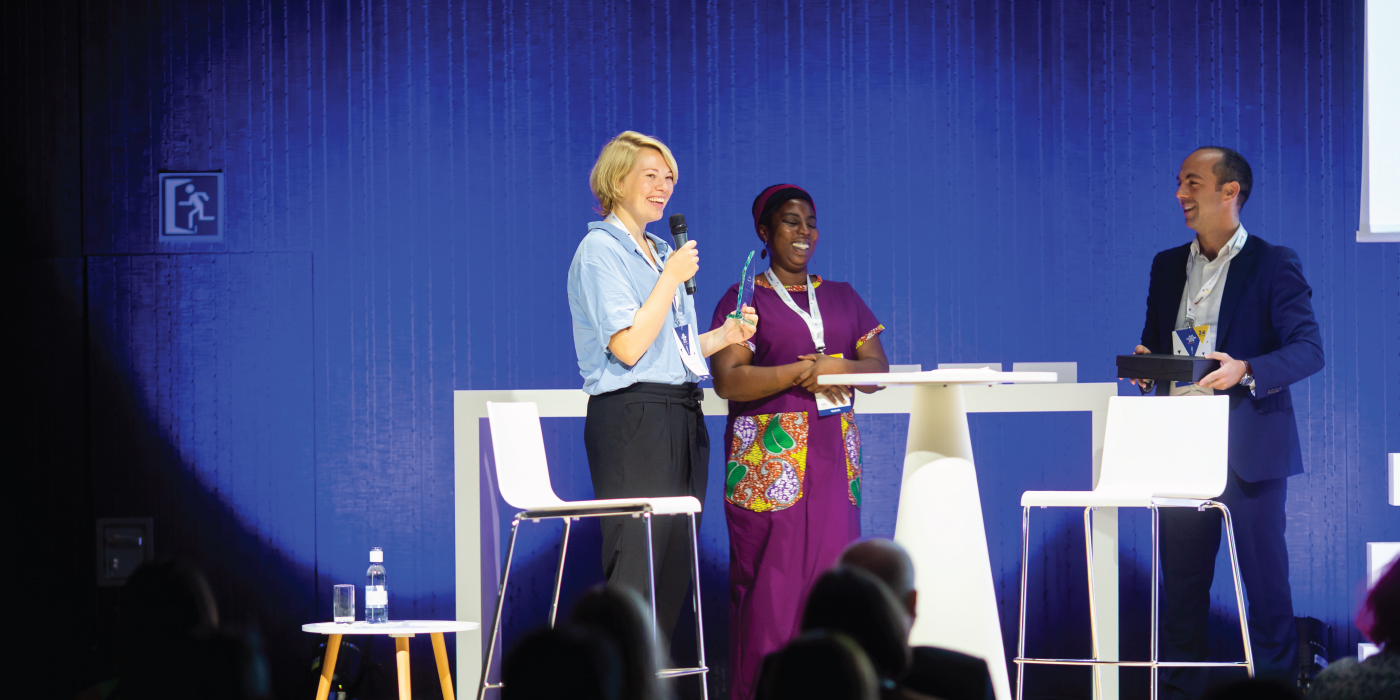Ending loneliness at the press of a button
With its one button to turn it on or off, Komp is a simple idea that won the hearts and minds of the judges of the second AAL Smart Ageing Prize, and won its creators a €35,000 first prize. Now, with money in the bank and the well-deserved recognition a prize like this provides, Komp is out to conquer Europe and put an end to loneliness and social isolation for millions of older people. Founding partner Catherine Karlson talked about the award and her plans for the future.
No Isolation, founded in Norway in October 2015, was a start-up with an ambitious mission. The group of researchers and technologists wanted to reduce involuntary loneliness and social isolation by developing communication tools designed to connect lonely people to friends, family and the world outside.
They started by working with children suffering with long-term illness who, by being immobile or bed-bound, were socially isolated. The loneliness these children faced was a huge part of their lives, but it didn’t necessarily have to be that way and so AV1 was born, a telepresence robot that acts as the child’s eyes, ears and voice in the classroom. Suddenly, lonely children could be back at school with their friends.
While developing AV1, No Isolation started to look more closely at the whole scope of loneliness and social isolation in the round and it soon became clear that they also needed to be working with older people. “It was a natural progression for us,” said Catherine Karlson, founding member of No Isolation, who was speaking after Komp picked up first prize and €35,000 for the AAL’s Smart Ageing Prize. “Older people have a very high risk of becoming lonely or socially isolated and there are things we can do about that.”
Karlson is quick to point out that it is not getting old in itself that makes a person lonely or socially isolated. There are many other factors involved and one of these is that the technology that surrounds society today doesn’t necessarily cater for the needs of the older person or has not been designed with some of the restrictions older people may face in mind.
“There is a lot of technology that does great things except take into account the needs of the older person,” she said. “Much of it doesn’t allow for things like loss of sight, dry finger tips and forgetfulness in remembering things like passwords. Meanwhile, in lots of cases where technology is useful for older people, many may not have used anything like it before so it needs to be made easy to use, which is often not the case.”
With this very basic premise in mind – that many older people are lonely and that technology can help them reconnect with society but much of the available tech is not suitable for their needs – Komp was born.
“We came up with the idea for Komp in February, 2016,” explained Karlson. “The whole team sat down together and, not thinking about anything other than loneliness and older people, we came up with many ideas before it hit us – something simple to use, requiring no digital skills can be used one end, while all the digital complexity can be at the other.
“We then came up with three very low-tech prototypes designed to connect analogue seniors with a digital family. We tested this basic idea, using cardboard and paper models, in many homes of older people in San Francisco and, despite them being some of the most tech-savvy seniors in the world, we learnt a huge amount.
“What it taught us was that however our ideas developed after this research phase, we needed something as simple as possible so we came up with the one button idea – you can’t go wrong with only one button and that became the whole concept behind Komp.”
So how does it work? Karlson emphasises, “it’s all very simple”. The older person simply turns a screen in their home on and off using the one button on the front, and then the rest of the family, with whom this person wants to be connected, is able to connect.
“All the issues of passwords and logging in etc are dealt with by the tech-savvy family rather than the older person,” explains Karlson. “The older person simply has to press the one button to connect and the family is able to share pictures, leave messages or speak via a video link. All the older person has to do, is turn it on or off.”
The development of a working prototype then followed which was taken out into the community for further testing. Karlson explains that it was important that this version of Komp was tested with people who said that they didn’t want technology in their home. “We figured that if they liked it, then we would have succeeded,” she said. “It became very important to us to focus on the people who don’t have technical skills.”
After this testing phase, Komp was launched on a small scale in Norway, where already 200 have been sold. This soft launch was designed as a way of testing if there was a general demand for this sort of device and whether or not people would actually buy it before it went into large-scale production.
“What is really good to see though is that with those 200 users, we now have seven family members connected to each screen – so it is clear that Komp is a thing that engages a whole family and we are encouraged by that.
“What is even better for us,” Karlson continued, “is that we would be speaking with older people who had a family they wanted to connect to, but they felt like they were intruding or being a burden when they were calling or they were expecting family to call them – and now we see that with Komp, they are reporting the opposite. The family is sending them things and, rather than being afraid to reach out, they see things coming into them all the time and this makes them very happy.”
With this positive feedback, Komp is now being rolled out in Scandinavia with new partners on board, including a retailer making it available in shops as well as online. After this, the plan is to take Komp into the rest of Europe. Of course, winning the prestigious AAL Smart Ageing Prize will not only provide them with tremendous encouragement that Komp has huge potential, but the €35,000 prize money will certainly help with the roll-out, too.
“We are definitely looking into further development now,” said Karlson. “We now cover the basic needs people have, but there are many other services that could be added that would be very relevant for older people once you get them online. That could be care providers or doctors connecting with them to do a care conference, for example, and we will be exploring these ideas now that we have some additional finance behind us.”
Apart from being able to see Komp grow and expand across Europe, Karlson sees winning the AAL prize as validation for the company’s “big idea” that communication tools don’t need to look the same on both sides. “The freedom that gives us to develop tools that work on both ends with people who don’t necessarily have the same digital skills or physical or cognitive capabilities is huge. What was available before wasn’t always working for the older person in the family.
“Of course, our overall aim is to put an end to loneliness and social isolation – so we will keep on learning and keep on exploring and, I hope, we will play a big part in people’s lives, people of all ages.”

